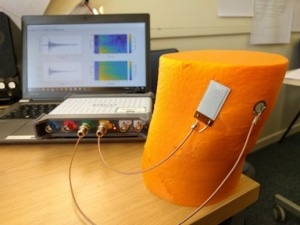Jan 24 2017
 A small non-invasive patch with a sensor can be worn on people�s skin ( e.g. knee) to check for arthritis. (credit: Care Home)
A small non-invasive patch with a sensor can be worn on people�s skin ( e.g. knee) to check for arthritis. (credit: Care Home)
A sensor that is typically utilized to detect damage in airplane wings could help to identify the early indications of arthritis via a user-friendly patch.
A team of researchers at Cardiff University consider the noise sensors used in aerospace technology, as important in detecting the ‘subsonic’ sound of cracking in a person’s joints, which is indicative of onset of Osteoarthritis (OA). OA affects the joints of elderly people.
The team consisting of structural and biomedical engineers is exploring acoustic emissions sensors, with the vision to create a small non-invasive patch composed of a sensor that can be worn on the skin of a person.
To detect joint damage, for instance, to the cartilage on the knee, the team plan to conduct a trial by placing knee patches with sensors on people this Spring. This will allow them to compare the sound made by healthy joints to the noise produced by the joints of people developing OA.
During the trials with volunteers, tracking and motion capture images of the knee will be performed by the acoustic sensor. The volunteers will be asked to perform basic activities such as climbing the stairs.
Dr Davide Crivelli, a mechanical engineer at Cardiff University aims to create a prototype patch in 12 months’ time.
The patches could be made available in GP surgeries within seven to 10 years. We are trying to listen to the high frequency noise of joints. We are trialing different sensors costing different prices.
Dr Davide Crivelli, Cardiff University
In comparison to the cost of the least expensive sensor trialed by researchers, which is 10p, the cost of the acoustic emissions sensors utilized in airplanes is very high.
Arthritis Research UK estimates over eight million people in the UK have opted to be treated for the condition. At present, the NHS spends millions on diagnosis via MRI scans and X-ray.
There is a good chance that the cost [to the NHS] will be lower than the cost of an MRI scan.
Dr Davide Crivelli, Cardiff University